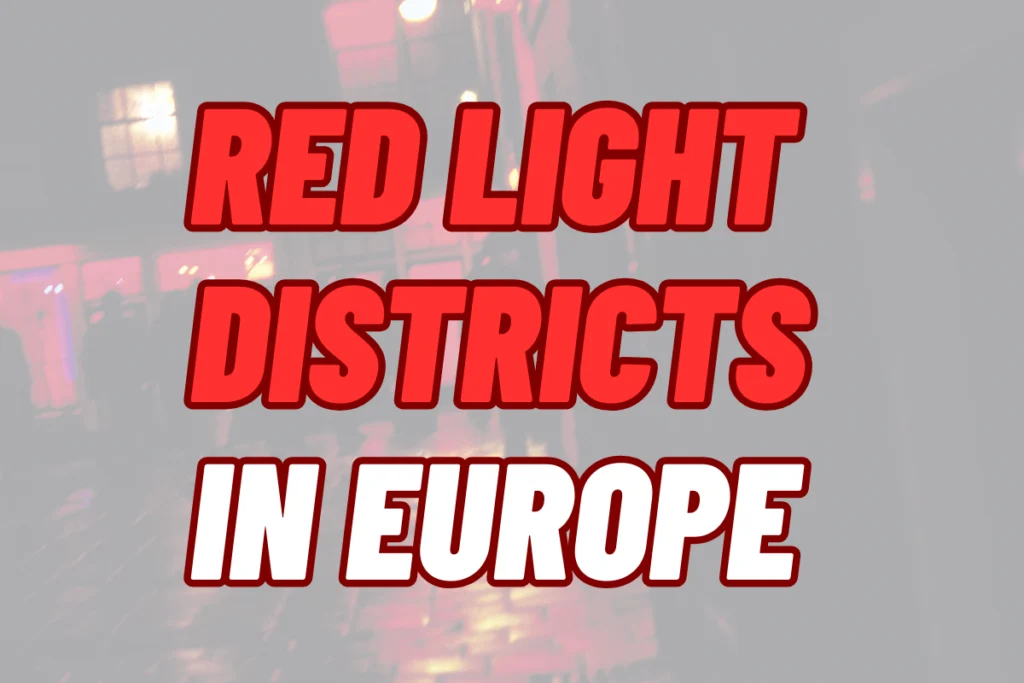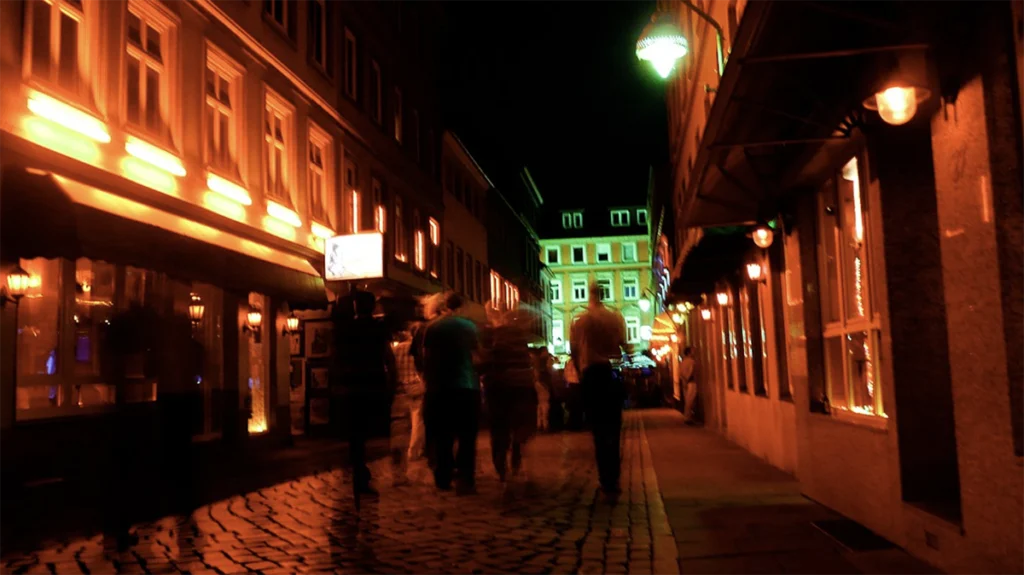A red light district is an area where sex work is openly practiced, occasionally regulated (or at least tolerated), and sometimes even tourist-friendly.
These districts vary wildly across Europe—some have been sanitized and gentrified to the point of near extinction, while others still pulse with neon-lit energy, a visceral glimpse into our continent’s seedy underbelly.
Amsterdam’s De Wallen remains the most iconic example, but red light districts exist in many European cities, and you can learn more about them in each of our city guides.
Earliest Examples of Red Light Districts in Europe

Red light districts as we know them today have their roots in centuries-old traditions where sex work flourished around busy trade routes, ports, and military barracks.
Throughout history, city officials and local authorities have oscillated between regulation, tolerance, and outright prohibition (still the case today!), but the demand for commercial sex ensured that certain districts became known as hubs for the profession, rife with street prostitution.
Medieval and Renaissance Europe: Early Prostitution Zones
We have to go back a LONG time to find the earliest examples of red light districts in Europe.
Paris – The Rue St. Denis
In fact, one of the earliest known red-light districts in Europe can be traced to medieval Paris, where the Rue St. Denis became synonymous with prostitution as early as the 12th century.
The street’s proximity to the Seine made it the perfect location for medieval sex workers to ply their trade. French authorities tried to regulate prostitution rather than eradicate it entirely, but they never really succeeded.
By the 13th century, King Louis IX sought to confine sex work to designated zones, and by the 15th century, brothels were licensed by the city. The Rue St. Denis remained a center of Parisian vice for centuries and continues to have a reputation for sex work today, even if most of the soliciting has moved over to the Internet instead.
London – The Southwark Stews
These days, you’d probably associate Soho with London’s red lights, but that hasn’t always been the case.
During the late Middle Ages, London’s most notorious red-light district was in fact… Southwark. Just across the Thames from the more conservative City of London. By the 15th century, the “stews”—a nasty term born from bathhouses where sex work took place—operated openly with the knowledge and tolerance of local authorities.
These grim little dens catered to sailors, soldiers, and traveling merchants (local and international). The Bishop of Winchester held jurisdiction over Southwark, and the brothels were sometimes referred to as “Winchester Geese” due to the fines levied on sex workers, which contributed to the church’s coffers.
Hamburg – The Birth of St. Pauli’s Reputation
We’ve written a lot about Hamburg, the major port city, and it first became a focal point for prostitution due to its bustling maritime trade. By the 17th century, the St. Pauli district had begun to emerge as a recognized zone for prostitution and punters (once again, most of them sailors!).
Over time, the area saw enough shagging to turn it into one of the most famous red-light districts in the world, with the Reeperbahn rivalling modern-day Amsterdam in the notoriety stakes.
Early Modern Period: The Rise of Institutionalized Brothels
As cities grew and economies became more interconnected, European governments took varying approaches to prostitution.
In Venice, the famed “cortigiane” (courtesans) were a key part of the city’s culture, with high-class courtesans wielding significant influence in aristocratic and literary circles.
The city even had official state-run brothels by the late Middle Ages.
In Amsterdam, prostitution was tolerated in the 17th century, with brothels operating openly in certain areas, particularly around the harbor. This tolerance continued into the modern era, leading to the formalization of the De Wallen (as mentioned above) district as a controlled red-light zone.
Many countries tried and failed to clamp down on their red light districts, some accepted and regulated certain areas, others went for prohibition and pushed the sex trade underground.
As you can see from our various guides, the absence of a recognised red light district does NOT mean an absence of a recognised sex trade.
Nearly every city sells sex.
Just not always in a designated zone.
Present Day Red Light Zones
Interestingly, many of the legendary early red-light districts have persisted into the present day. In some way or another…
The locations have remained largely unchanged due to their historical roles as centers of commerce, nightlife, and tourism. The same factors that made them hotspots in the Middle Ages—high foot traffic, male-dominated professions like maritime trade, and lenient local governance—continue to sustain them today.
Modern red-light districts such as Amsterdam’s De Wallen, Hamburg’s Reeperbahn, and Paris’s Pigalle (which developed in the 19th century) reflect the long-standing tradition of prostitution being concentrated in urban areas.
Simple supply and demand, you might say.
These districts have inadvertently become tourist attractions, leading to the wholly weird scenario where you have tourists and punters combing prostitution windows side by side.
Where commerce and vice converge, red-light districts continue to thrive, echoing the past in both form and function.
What Red Light Districts Are Still Active Today?
Probably more than you think!
Busy nightlife + tourism is the perfect infrastructure for vice to thrive.
We’ve detailed the known red light districts for some of Europe’s biggest cities (over 60 in total), and we highly recommend you start there for the latest intel.
However, there are some districts that need no introduction…
Amsterdam – De Wallen
The mother of all red light districts. A narrow, canal-lined labyrinth packed with neon-lit windows displaying lingerie-clad sex workers to passing crowds.
It’s as much a tourist attraction as it is a working district, with thousands passing through nightly. Legalization and regulation ensure some level of safety, but the city has been pushing for a shift away from the chaotic, stag-party-fueled image of the area.
In our view, Amsterdam’s sex scene is actually in decline. De Wallen is a shadow of its former self, now dominated by tourists as opposed to actual punters.
Still, if you ask an American to name one red light district in Europe, he’d probably stick a pin in the map directly over Amsterdam. (If he can find it, at least. 😂)
Hamburg – St. Pauli & Herbertstraße

A legendary mix of sex, rock & roll, and neon-lit sin.
St. Pauli’s Reeperbahn is a sprawling red light district where strip clubs, brothels, and sex shops blend into one of Germany’s most famous nightlife areas.
Herbertstraße, a small side street, remains strictly male-only, with large barriers blocking the view from prying eyes.
Antwerp – Schipperskwartier
A small but well-organized district where window prostitution operates under strict Belgian regulation.
Antwerp’s red light district is more discreet than Amsterdam’s, with a cleaner, business-like atmosphere.
Don’t expect the same raucous nightlife, or the constant footfall of tourists, either.
Frankfurt – Bahnhofsviertel
Frankfurt’s red light district, right next to the city’s main train station, is gritty, raw, and downright dirty.
While legalized brothels exist are plentiful in the city, this particular area has a reputation for heavy drug use, crime, and a darker side of the sex trade.
Not exactly a tourist attraction, but still a major hub for sex work in Germany.
Paris – Pigalle
Once the heart of Parisian vice, Pigalle has been heavily gentrified, but remnants of its red light past remain in the form of erotic cabarets, peep shows, and massage parlours.
It’s a far cry from the fully operational districts of other cities, but the neon glow of places like the Moulin Rouge keeps the area’s legacy alive. Again: very popular with tourists.
Street Prostitution
Red light districts and street prostitution often go hand in hand, but let’s be real: it’s not the smartest option.
While some cities have designated areas for street-based sex work (e.g., Zurich’s sex drive-in zones), in most places, it’s a last resort for workers facing poverty, trafficking, or lack of access to legal brothels.
We’d be particularly skeptical of hiring a street hooker in a city where licensed brothels or sex clubs exist. If she’s not working for those… then you have to ask, why?
If you’re in a city where legal, regulated options exist, using street workers is reckless and unnecessary.
There are safer, professional alternatives (like escorts) that don’t involve haggling in a dimly lit alley with the possibility of getting burgled (or the clap).
Just don’t do it.
Common Scams in Red Light Districts
On the subject of safety…
If you’re planning to visit a red light district, it pays to know what-in-the-actual f— you’re doing.
Trust us!
While some red light districts are well-regulated, others are rife with scams, hustlers, and rip-offs.
Here’s what to watch out for:
- The Champagne Scam: You enter a club, sit with a girl, and suddenly you’re hit with an astronomical bill for “drinks.” If you refuse to pay, security gets involved. This is commonplace all over Europe, although it’s actually an export from Tokyo’s shady kyakuhiki scams.
- The Wallet Snatch: A hooker will grope and tease you while an accomplice (e.g. her drugged-up pal) lifts your wallet and heads off into the night. Particularly common in Amsterdam and Barcelona.
- The Overcharge Trick: You agree on a price, but when the session ends, suddenly there are “extra charges” for time, activities, or OTT fees. This is not so much an issue with red light districts, but just the general trustworthiness of the hookers than work on the street.
- The Closed Curtain Switch: A worker invites you in, pulls the curtain, and—surprise!—it’s someone completely different.
- The Police Shakedown: In cities where sex work operates in a legal gray area, corrupt cops might approach you after a session and demand a bribe. More common in Asia, but still a risk, particularly in Eastern Europe (especially those common with sex tourism).
Our advice for all of the above is simple: stay vigilant and if it doesn’t look right, get the hell out of there.
Don’t let your ball-sack override your brains.

